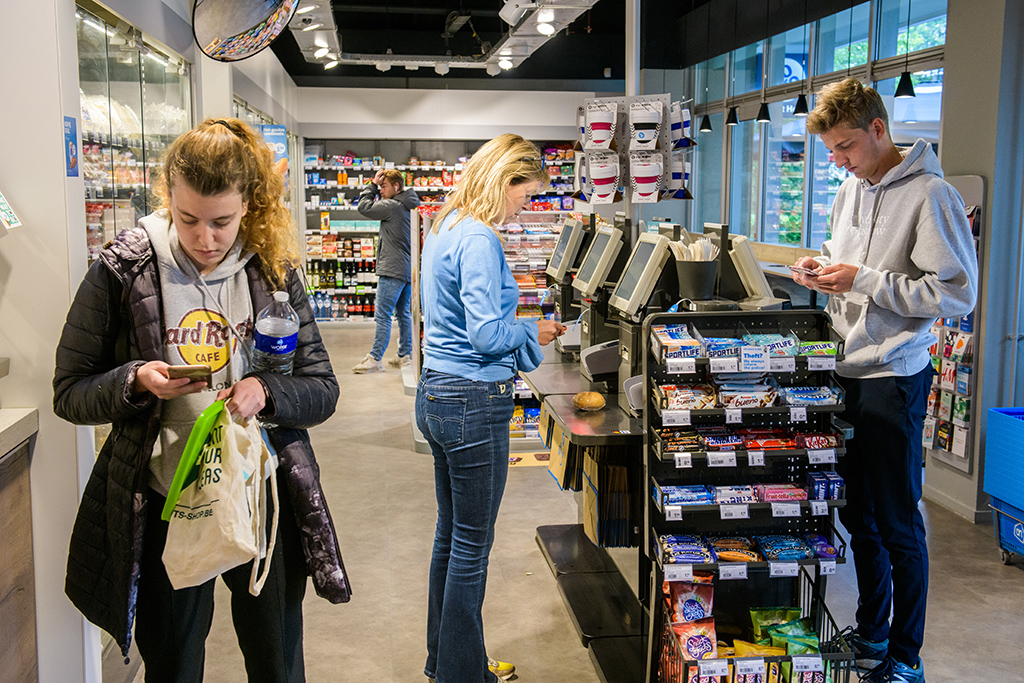Cake or Carrots? How Supermarket Apps Influence Our Food Choices
Swiping through the Albert Heijn app can feel a lot like online shopping: attractive images everywhere, with buttons like ‘popular’ or ‘price favorite’ at every turn. Students from Tilburg University investigated how supermarket apps influence our eating behavior, because even online, we’re steered toward certain products.

Most consumers know that name-brand products are placed at eye level and that the smell of fresh bread is meant to tempt you into buying. But how things work in supermarket apps is less well known. Students from Tilburg University, together with think tank Questionmark, investigated exactly that.
While browsing different products in supermarket apps, Communication and Information Sciences students Jarod Leijten and Pam Hendrix noticed something: healthy products are often displayed more attractively than unhealthy ones. ‘In the Albert Heijn app, for example, bread is beautifully photographed on a wooden board, but only the healthier options, like whole grain bread,’ says Pam. ‘White bread is just shown in its plastic packaging. You notice that once you start paying attention.’
A Lot of Effort Goes Into Presentation
Online-only supermarket Picnic also scores high when it comes to attractive product images. That’s no surprise, according to Leijten. ‘Picnic doesn’t have physical stores, so they have to make everything look appealing online. A lot of work goes into the presentation, especially since you can’t smell or touch anything digitally.’
From Grandma’s Kitchen
It’s not just images, language also plays a big role in supermarket apps. ‘For low-fat yogurt, you’ll see words like ‘organic,’ ‘healthy,’ and ‘fresh.’ But for vanilla yogurt, the emphasis is more on experience, with words like ‘creamy,’ ‘nostalgic,’ or ‘from grandma’s kitchen’,’ Hendrix explains. ‘They’re selling a feeling.’
Nudging Towards Healthy Choices
So what about the balance between healthy and unhealthy options? Of the apps they studied, Albert Heijn stood out for its use of nudging (a behavior-influencing technique) to promote healthier choices. ‘Albert Heijn often shows you healthy products alongside recipe suggestions,’ says Leijten. ‘That makes it easier to go for something healthy right away. Jumbo does this less, they have a separate recipe page instead.’
Still, they noticed that discounts like ‘buy one, get one free’ or ‘now 25% off’ are often linked to less healthy products. ‘These kinds of deals are even more noticeable online than in-store,’ says Hendrix. ‘You get them almost literally shoved in your face through the app.’
Setting Limits on Unhealthy Products
Leijten and Hendrix believe stricter regulations around product recommendations are worth considering. ‘Especially for unhealthy products, there should be some kind of limit,’ says Leijten. ‘Not a ban, but steering toward more balance. For example, eight out of ten recommended products should be healthy.’
Hendrix adds, ‘It’s also problematic that unhealthy food is often cheaper than healthy food. A sugar tax could be a logical solution.’
They advise consumers to shop mindfully. ‘Search purposefully and go straight to checkout,’ Hendrix suggests. ‘If you keep scrolling, you’ll keep encountering temptations. And always check whether something is truly healthy, fancy words don’t mean much.’
Sometimes You Still Fall for It
The research also affected their own shopping behavior. ‘I didn’t notice these things before,’ Leijten admits. ‘Now I do. When I see a discount, I ask myself: do I really need this? And yeah, sometimes I still fall for it. I’m only human.’ Hendrix adds, ‘I haven’t necessarily changed what I eat, but now I clearly see how subtly you’re being steered in these apps.’
Pam and Jarod conducted this research for the course Technology for a Healthy Lifestyle, part of the Digital Health minor. The case study was provided by Questionmark. This minor is open to all undergraduate students at the university.






